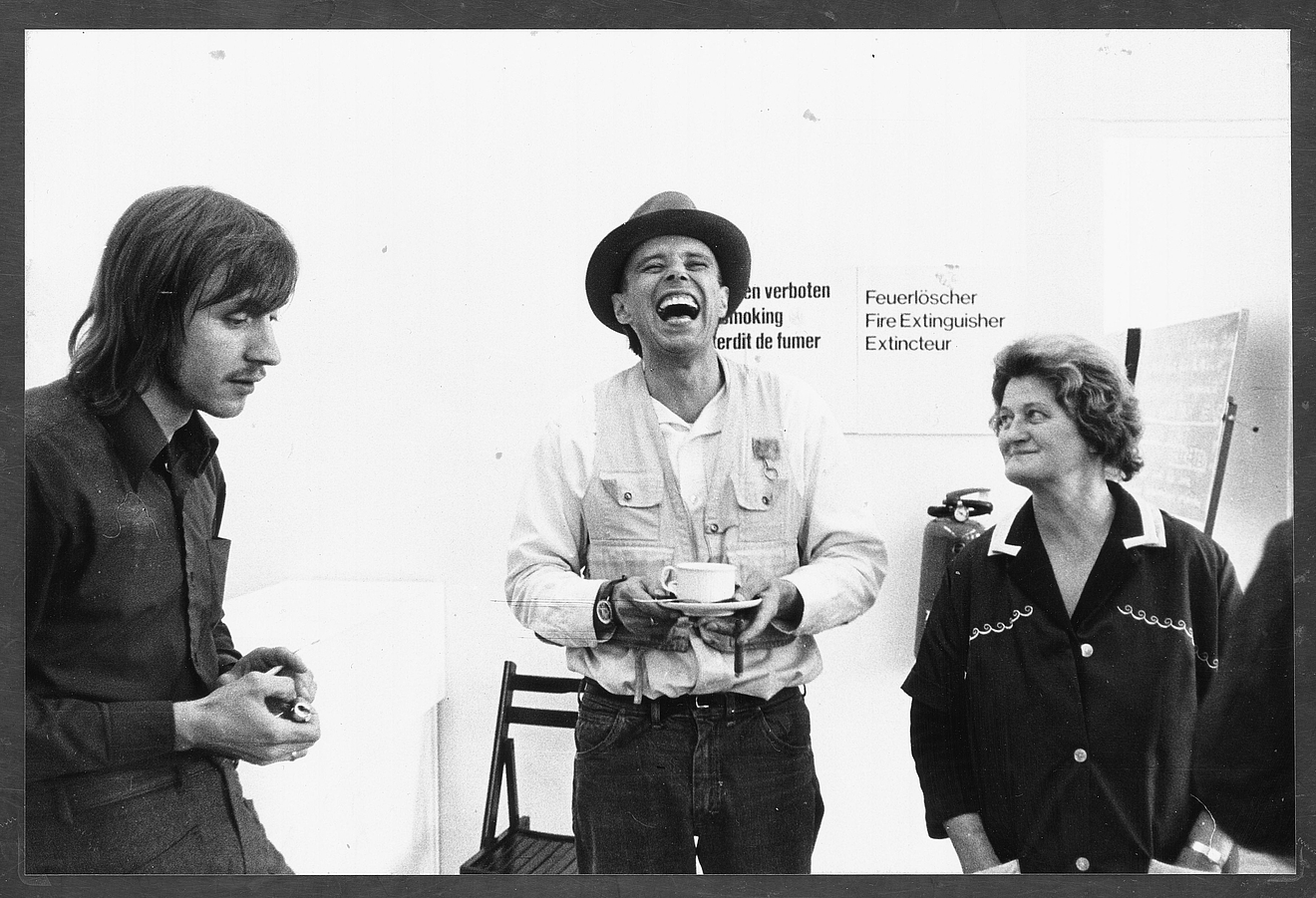Joseph Beuys is considered one of the most important protagonists of twentieth century art. His extensive oeuvre ranges from traditional forms of representation such as drawing, painting, and sculpture to multiples, large-scale installations, and public actions. Through these, he brought his Expanded Concept of Art to life within the frameworks of his actions and as a political speaker and activist.
With nearly 6,000 items, the Museum Schloss Moyland Foundation owns the world’s largest collection of works by Joseph Beuys.
1921
Born on 12 May in Krefeld, family moves to Kleve in autumn.
1931–1940
Attends the Staatliche Gymnasium (public secondary school) in Cleve (since 1938 Hindenburg Oberschule – Staatliche Oberschule für Jungen).
1940–1945
Voluntarily reports to the Air Force in late summer 1940. Trained as an aircraft radio operator. Deployed as radio operator and gunner in dive bomber squadron, especially in southern Italy, Croatia, the Ukraine and the Crimean Peninsula. 1944 crash in the Crimea. In British captivity after the German capitulation, released in summer 1945.
1946–1951
Studies sculpting at the Staatliche Kunstakademie (state academy of arts) in Düsseldorf, first under Joseph Enseling, from 1947 under Ewald Mataré. Completes his degree 1951, graduating from Mataré's master class. First acquisition of works by the brothers Hans and Franz Joseph van der Grinten in Kranenburg. Beuys shares a studio with Erwin Heerich under the roof of the academy from 1951 until his ex-matriculation in 1954.
1953
First solo exhibition in the van der Grinten house in Kranenburg.
1957–1958
Stays in Kranenburg in the van der Grinten house in early summer 1957, recovering from a severe artistic and psychological crisis. Participates in an international competition for a memorial in the former concentration camp Auschwitz-Birkenau. Beuys gets a studio in the former Kurhaus (spa) in Kleve.
1959
Completes the memorial for the dead of the two World Wars in the community Büderich near Düsseldorf. Marries Eva Wurmbach.
1961
Becomes professor of monumental sculpture at the Staatliche Kunstakademie Düsseldorf. Beuys rents a studio at Drakeplatz in Düsseldorf-Oberkassel. Exhibition with works from the van der Grinten collection in the Städtische Museum Haus Koekkoek in Kleve.
1963–1965
Hans and Franz Joseph van der Grinten organise the so-called stable exhibition ‘Josef Beuys. Fluxus’ in the van der Grinten house in Kranenburg. First performances, participation in the ‘documenta III’ in Kassel and first solo exhibition in the Galerie Schmela in Düsseldorf 1965.
1967
Solo exhibition in the Städtische Museum Mönchengladbach. The collector Karl Ströher acquires nearly all exhibited works.
1967–1972
1967 founds the Deutsche Studentenpartei (German student party). 1968 participates in the 'documenta IV' in Kassel. 1970 founds the Organisation für Nichtwähler – Freie Volksabstimmung (organisation for non-voters – free public referendum) and 1971 founds the Organisation für direkte Demokratie durch Volksabstimmung (organisation for direct democracy through public referendum) with Karl Fastabend and Johannes Stüttgen. 1971 exhibition in the Moderna Museet in Stockholm ‘Joseph Beuys – Aktioner Aktionen, Zeichnungen und Objekte 1937–1970 aus der Sammlung van der Grinten’ (Joseph Beuys – actions, drawings and objects 1937-1970 from the van der Grinten collection).
1972
Participates in the ‘documenta 5’ with the Büro der Organisation für direkte Demokratie durch Volksabstimmung (bureau of the organisation for direct democracy through public referendum). ‘Occupation’ of the administration office of the Kunstakademie in Düsseldorf in October 1972 to enforce the acceptance of rejected applicants. Beuys’s professorship is terminated without notice. The subsequent legal battle ends in 1978 with a settlement.
1972–1974
Lecture tour in England, Ireland, Scotland, Italy and the USA to disseminate his idea of the Soziale Plastik (social sculpture).
1973
Founds the Verein zur Förderung einer Freien Internationalen Hochschule für Kreativität und Interdisziplinäre Forschung e. V. (association for the advancement of a free international university for creativity and interdisciplinary research) with Heinrich Böll and Klaus Staeck. Later, the Free International University (F.I.U.) develops out of this, operating in various places in Germany, Ireland, Scotland, Italy and the Netherlands.
1976
Participates in the 37th Biennale in Venice with the installation ‘Strassenbahnhaltestelle/Tramstop/Fermata del Tram 1961–1976 – A monument to the future’. Beuys is top candidate for North Rhine-Westphalia in the federal parliamentary elections and candidate with a direct mandate of the party AUD (Aktionsgemeinschaft Unabhängiger Deutscher – committee of independent Germans).
1977
At the 'documenta 6' Beuys implements the installation ‘Honigpumpe am Arbeitsplatz 1974–1977’ (honey pump at the workplace 1974–1977). Workshops of the Free International University (F.I.U.) are part of the artwork.
1979
Major retrospective at the Solomon R. Guggenheim Museum in New York.
1980
Participates in the founding convention of the Grünen (green party) in Karlsruhe. Participates in the 39th Biennale in Venice with the installation ‘DAS KAPITAL RAUM 1970–1977’ (the capital room 1970–1977). Beuys is the green party's candidate with a direct mandate for the constituency Düsseldorf-Nord (North Düsseldorf). The Freie Internationale Universität (free international university) opens in room 3 of the academy of arts in Düsseldorf.
1982
Beuys takes part in the ‘documenta 7’ with his project ‘7.000 Eichen – Stadtverwaldung statt Stadtverwaltung’ (7,000 oaks – city forestation instead of city administration). The last tree is planted after his death in 1987 by his son Wenzel.
1985
In December, Beuys mounts his last installation, ‘Palazzo Regale’ (royal palace), in the Museo di Capodimonte in Naples.
1986
On 12 January, Beuys delivers his last speech at the awards ceremony for the Wilhelm Lehmbruck-Preis of the city of Duisburg. On 23 January, Joseph Beuys dies in Düsseldorf.


